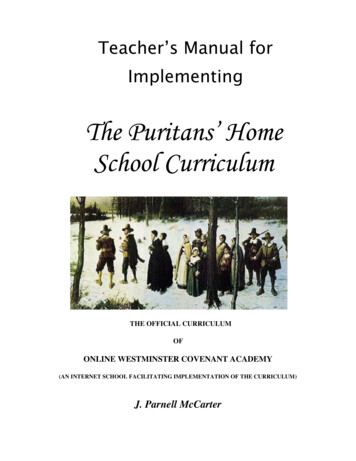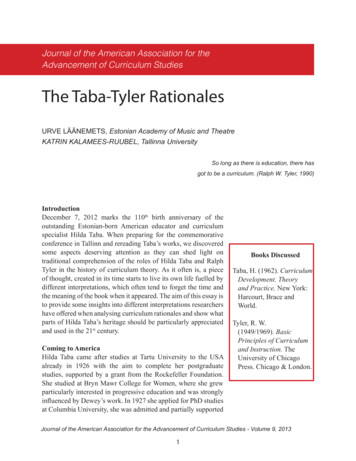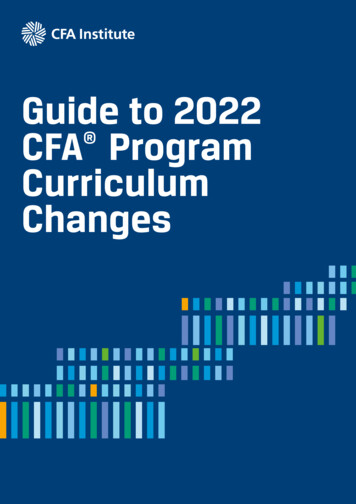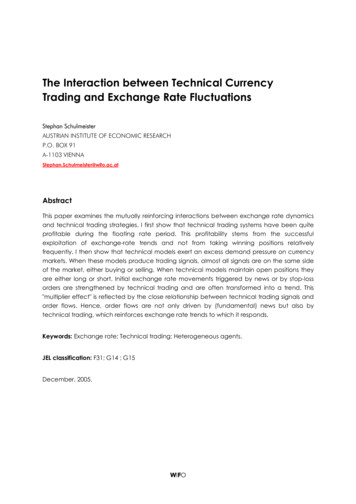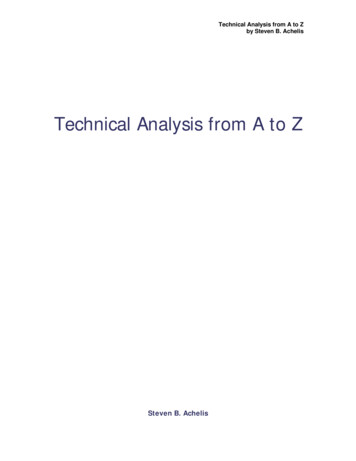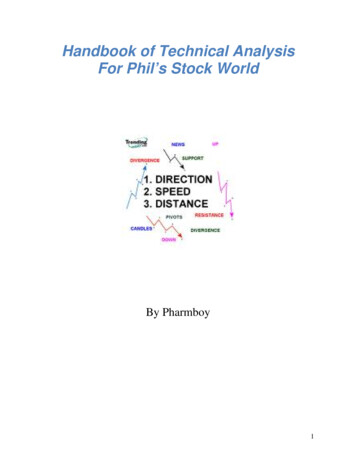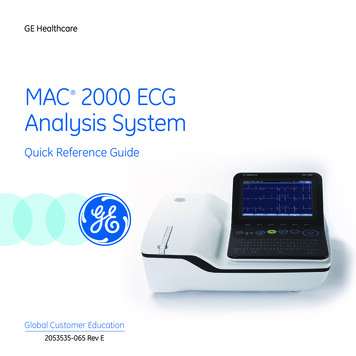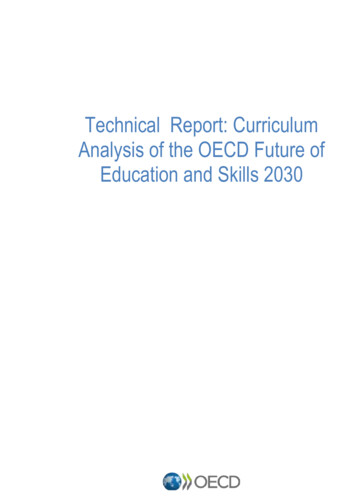
Transcription
1Technical Report: CurriculumAnalysis of the OECD Future ofEducation and Skills 2030PUBE
2 1 Overview of the types of curriculumanalysis in the Future of Educationand Skills 2030 projectThe series of volumes on curriculum analysis synthesise rich, mixed-methods datacollected from a variety of sources and stakeholders. Working methods and sources ofinformation include: Reviews of existing research Policy survey on curriculum redesign (PQC) Curriculum content mapping (CCM) Mathematic Currriculum Document Analysis (MCDA) Physical Education Curriculum Analysis (PECA) Consultation and discussion with policy makers and curriculum expertsReviews of existing researchResearch syntheses (traditional literature reviews, systematic reviews and meta-analyses)and landmark papers on curriculum were reviewed and their key messages and learningsextracted. Data from existing OECD data sources relevant to curriculum was alsoreviewed, including indicators from Education at a Glance (EAG), the Programme forInternational Student Assessment (PISA) and the Teaching and Learning InternationalSurvey (TALIS).Policy Questionnaire on CurriculumThe aim of the PQC was to give countries and jurisdictions the opportunity to learn frompeers about good practices in and challenges faced in the curriculum redesign process. Italso provided an opportunity for self-reflection so that countries could position theircurriculum (e.g. visions, educational goals and expected student outcomes).Thirty-seven countries and jurisdictions are represented in the PQC data. Questionnaireswere completed by government representatives in 33 countries/jurisdictions: OECDcountries/jurisdictions Australia, Bristish Columbia (Canada), Chile, Czech Republic,Denmark, Estonia, Finland, Hungary, Ireland, Japan, Korea, Lithuania, Mexico,Netherlands, New Zealand, Norway, Ontario (Canada), Poland, Portugal,TECHNICAL REPORT: CURRICULUM ANALYSIS OF THE OECD FUTURE OF EDUCATION AND SKILLS2030 OECD 2020
3Québec (Canada), Scotland (United Kingdom), Sweden, Turkey, Wales (United Kingdom),and partner countries/jurisdictions Argentina, China, Hong Kong (China), Costa Rica,Kazakhstan, Russian Federation, Singapore, South Africa, and Viet Nam. Questionnaireswere completed by 4 researchers from United Kingdom (Northern Ireland), United States,Brazil, and India.Curriculum Content MappingThe Curriculum Content Mapping (CCM) was a document analysis exercise in whichcountries/jurisdictions explored the extent to which different competencies are included intheir current curriculum, and how. By mapping seven learning areas of the curriculumagainst a list of 28 competencies stemming from the Learning Compass 2030, countriesexplored how knowledge is intended to be taught together with skills (e.g. critical thinking,creative thinking, cooperation/collaboration) as well as attitudes and values (e.g. respect,empathy).Sixteen countries/jurisdictions participated in the CCM exercise: OECDcountries/jurisdictions Australia, British Columbia (Canada), Estonia, Greece, Israel,Japan, Korea, Lithuania, Northern Ireland (United Kingdom), Portugal, Saskatchewan(Canada), Sweden, and partner countries: China, Kazakhstan and Russian Federation forcomparative analysis. One country, the Nethelands, participated in the self-reflectionexercise.Detailed information on the CCM methodology will be detailed below.Mathematics Curriculum Document AnalysisThe Mathematics Curriculum Document Analysis (MCDA) project investigates the extentto which countries have incorporated 21st century skills in their current mathematicscurriculum. Participating countries identify one or more mathematics experts to take partin a weeklong workshop on coding relevant and desired mathematics curriculumdocuments, including curriculum guides and textbook materials, making use of the21st Century Mathematics Framework developed for MCDA in conjunction with PISA 2021.Benefits for participating countries include: 1) learning the extent to which the PISA 2021concept of mathematics literacy is represented in one’s current mathematics curriculum;2) comparing one’s own mathematics curriculum to contemporary internationalbenchmarks; 3) informing ongoing reform efforts towards a 21st century vision ofmathematics education; and 4) creating a contemporaneous mathematics curriculumprofile to provide a relevant interpretive context for one’s PISA 2021 mathematics literacyperformance. MCDA coding workshops were held in February, March, June andSeptember 2019. An MCDA expert meeting is being held in October 2020 to discuss theresults of the coding workshop and prepare a report on the findings, which will be publishedmid-2020.Government-nominated representatives participated from 16 countries and jurisdictions,including Argentina, Australia, Estonia, Greece, Hong Kong (China), Hungary, Israel,Kazakhstan, Korea, Latvia, Lithuania, the Netherlands, New Zealand, Norway, Portugaland Sweden. Researchers participated 3 countries and jurisdictions, including Japan,United States and Chinese Taipei: as their input was provided by independentresearchers, it may not represent official views from government institutions.
4 Physical Education Curriculum AnalysisThe stock-taking exercise on physical health education marks the first time that the OECDhas focused on physical and health education as part of its policy analysis. It takes stockof research evidence on the effects of physical education/health education. It will also aimto uncover new knowledge on the state of physical education/health education policies,curriculum, practices and perspectives in various countries.Eighteen countries/ jurisdicitons participated:15 with government representatives fromAustralia, Canada (Ontario), Chile, People’s Republic of China, Estonia, Hong Kong(China), Japan, Kazakhstan, Korea, Portugal, Russia, Switzerland, Turkey, UK (Scotland,Wales); 3 with researchers from England, Luxembourg, Norway.The results were synthesised into a publication “Making Physical Education Dynamic andInclusive: international curriculum analysis”.1 It was launched at the project’s meeting,hosed in Ilsen, Korea, in November 2019Consultation and discussion with policy makers and curriculumexpertsAs with all strands of activity of the Education 2030 project, the international curriculumanalysis drew heavily on the expertise and experience of government representativesinvolved in the project. One valuable outcome of this collaboration was the identificationof a series of principles that could be used to guide effective redesign of cation/2030project/contact/OECD FUTURE OF EDUCATION 2030 MAKING PHYSICAL DYNAMIC AND INCLUSIVE FOR 2030.pdfTECHNICAL REPORT: CURRICULUM ANALYSIS OF THE OECD FUTURE OF EDUCATION AND SKILLS2030 OECD 2020
52 Policy Questionnaire on CurriculumRedesign MethodologyWhat is the Policy Questionnaire on Curriculum Redesign (PQC)?The aim of the PQC was twofold: to give countries/jurisdictions the opportunity to learnfrom peers about good practices in and challenges faced in the curriculum redesignprocess and to provide countries/jurisdictions with an an opportunity for self-reflection toposition their curriculum (e.g. visions, educational goals and expected student outcomes).Notions of curriculum and approaches to curriculum redesign are particularly diverseacross countries and jurisdictions. To capture this diversity, the PQC questionnaire wasdesigned with an explotatory approach. With this purpose, the PQC questionnaire includedopen-ended questions intended to not limit responses to a discrete categorisationdesigned ex-ante. The resulting raw dataset is thus qualitative in nature and provides richnarratives of experiences in curriculum redesign.The target of this questionnaire was the curricula provided for students who study atISCED 2 (Lower Secondary) level general education institutions.Questions in the PQC questionnaire were organised in 4 thematic blocks. Each of theseblocks is further divided into subcategories exploring particular approaches andexperiences regarding curriculum redesign.These blocks are:1. Contextual information: designed to collect contextual informationnecessary to better understand country-specific circumstances regardingcurriculum.Questions include: Major government visionary policies, declarations or statements; Legal regulation/s; Education courses and curricula; Teachers’ and students’ autonomy; Extra-curricular activities; Curricula provided for specific student groups.2. Current curriculum: designed to map the current curricula focusing onits scope.Questions include various aspects of curriculum including goals, values, coverage,textbooks, instruction time and transition, and cover the following topics:
6 Difference/similarity of education goals, including subject-specific goals,across nations; How values are described or embedded in curricula; Total intended instruction time; How countries make curricula at different education levels coherent,particularly in relation to learning progression for students through theeducation levels ISCED 1-3; How textbooks and/or other teaching/learning support materials are developedand made coherent with (or aligned to) a curriculum.3. Trends in curriculum redesign: designed to grasp the recent trends ofcurriculum redesign.Questions in this section cover the following topics: Trends in the frequency of changes (e.g. countries have changed theircurricula more frequently in order to keep pace with societal change); Flexibility of changes (e.g. countries have changed specific subjects or contentinstead of periodically redesigning the whole curriculum); Interrelationship between changes in goals, subjects, content, instruction timeetc.; Lessons learnt from past reforms and unintended consequences; Future planning of curriculum redesign; directions in which countries aremoving; Challenges countries are facing and strategies they are applying/will apply todeal with these challenges.4. Process of curriculum development, implementation and monitoring:focusing on the process of curriculum, from its development toimplementation and monitoring.Questions in this section cover following topics: Players involved in the process of curriculum development, implementationand monitoring; Strategies and key mile-stones in the curriculum development process; Strategies and the roles of stakeholders in the curriculum implementationprocess; How the implementation process is monitored.How were PQC responses analysed?Qualitative responses in the PQC questionnaire were analysed following a carefulmulti-stage coding and validation process. Figure 1 outlines key stages in this process.These include:TECHNICAL REPORT: CURRICULUM ANALYSIS OF THE OECD FUTURE OF EDUCATION AND SKILLS2030 OECD 2020
70. PQC questionnaire:The questionnaire was based on the real policy needs when redesining curriculum; i.e. thequestionnaire itself was co-developed with participating countries/jurisdictions in aniterative process. Countries/jurisdictions first identified common curriculum redesignchallenges (time lag dilemma, curriculum overload, quality of curriculum contents, balancebetween quality and equity of curriculum, planning for effective implementation), whichwere then translated into the questionnaire. It targeted governments or other agents whoare responsible for designing curricula and implementation plans. National coordinatorsnominated by 33 countries/jurisdictions along with the academic experts from4 countries/jurisdictions completed the questionnaire in an iterative process between 2017and 2019. As the purpose of the questionnaire was also to facilitate discussion andpeer-learning, raw country/jurisdiction responses were shared with other participatingcountries early on in the process.1. Qualitative coding - Stage 1 (Framework definition):The first stage in this analytical process consisted on a qualitative coding to identify keythemes and categories emerging from PQC responses. The result of this stage was amapping framework including key themes and categories. To facilitate cross-countrycomparability, categories in this framework are not completely exhaustive and in somecases not fully discrete. This has been highlighted wherever possible and suits the purposeof increasing comparability of the data while acknowledging the complexity of nationalcontexts.2. Qualitative coding - Stage 2 (Response mapping):Country responses were then mapped to categories based on the framework definedunder stage 1. This process was undertaken simoultaneously and independently by tworesponse-coders. Any discrepancies in the resulting code were then reconciled by a codereviewer. This approach was taken to address any challenges in inter-rater reliability. Theresult of this stage was a preliminary dataset comprising cross-country PQC tablesaddressing key themes in the questionnaire.3. Country validation:Preliminary PQC tables resulting from this coding exercise were then validated bycountries/jurisdictions participating in the study. In this process, countries/jurisdictionsvalidated the response mapping and provided complementary information to supplementthe preliminary dataset. The result of this process was a final dataset comprising crosscountry PQC tables validated by countries.
8 Figure 1. Multi-stage PQC analysis overviewTECHNICAL REPORT: CURRICULUM ANALYSIS OF THE OECD FUTURE OF EDUCATION AND SKILLS2030 OECD 2020
93 Curriculum Content Mapping (CCM)What is Curriculum Content Mapping (CCM)?Background of the CCM exerciseThe OECD Education 2030 project was proposed at the 17th meeting of the EducationPolicy Committee in April 2015. The project provides the opportunity to explore the biggerpicture and the longer-term challenges of education. It aims to contribute to making theprocess of curriculum design and development more evidence-based and systematic.The project was launched with two main strands of activities:‒Development of a future-oriented learning framework that sets out the types ofknowledge, skills, attitudes and values which today's students will need to thriveand shape the future towards a better future in 2030, using the commonlanguage in the framework across different countries and across differentstakeholders .‒International curriculum analysis that can build a knowledge base and contributeto making the process of curriculum design and development moreevidence-based and systematic, in particular, to address commonly identifiedchallenges among participating countries.On the basis of these strands, the OECD Learning Compass for 2030 has been co-createdwith a wide range of stakeholders, building on a solid research base and theoreticalunderpinnings. Subsequently, three types of activities have been conducted: the PolicyQuestionnaire on Curriculum Redesign (PQC); In-depth subject-specific curriculumanalysis (the selected subjects include Mathematics and Physical and Health Education.);and the Curriculum Content Mapping (CCM) exercise in comparison with the OECDLearning Compass for 2030. The CCM exercise is one of the key curriculum analysisactivities, while at the same time drawing on the OECD Learning Compass for 2030.Goals of the CCM exerciseA "competency" is a holistic and dynamic concept, which includes knowledge, skills,attitudes and values. However, when designing a competency-based curriculum, countriesoften face a false dichotomy of "knowledge" versus "skills, attitudes and values" regardingwhat students need to learn at school.To avoid the false dichotomy and identify or confirm the extent to which and howcompetencies are included in their current curriculum and the curricula of other countriesand with a more granular analysis, the CCM exercise aims to support countries to:‒Explore how knowledge is intended to be taught together with skills (e.g.criticalthinking, creative thinking, cooperation/collaboration) as well as attitudes and
10 values (e.g. respect, empathy). This can help countries better understand howparticular skills, attitudes and values are more/less relevant to certain learningareas/ subjects.‒Identify how emerging demands for interdisciplinary competencies (e.g. globalcompetency, digital literacy) can be accommodated in existing learning areas.This can help countries to avoid further crowding the curriculum by adding newlearning areas or subjects.‒Explore where today’s intended curricula stand with respect to the increasinglyimportant dimensions that are articulated as key concepts, competencies andconstructs that are required for today’s students to build a new future in theOECD Learning Compass for 2030. This can help countries to reflect on possiblegap areas between today’s curriculum and future needs.Value of the CCM exerciseCountries that took part in this exercise have provided good opportunities for bothself-reflection and peer-learning among countries (see Appendix Self-reflection andinsights from E2030 CCM participating countries and jurisdictions). Following thecompletion of the mapping process, the CCM exercise enables countries to usecomparative data:‒To monitor/ review their current curriculum in relation to the selectedcompetencies.‒To inform future curriculum development/ redesign initiatives.In addition, the data obtained from the CCM can provide data to support other analyses,including: valuable companion information to the OECD Learning Compass for 2030as well as data obtained from the Policy Questionnaire on Curriculum(i.e. the written curriculum); contextual information for case studies on school practice (i.e. theimplemented curriculum); contextual information for consideration with PISA data (i.e. the achievedcurriculum); and overarching information on the inter-relationships between differentaspects of knowledge, skills, attitudes and values, which can assist thefurther analysis of specific learning areas (e.g. physical education/ health;mathematics).TECHNICAL REPORT: CURRICULUM ANALYSIS OF THE OECD FUTURE OF EDUCATION AND SKILLS2030 OECD 2020
11Scope of the CCM exerciseTo ensure cross-country comparability, the scope is as following:Educational LevelThe scope of the target educational level for the CCM exercise is inclusive of all grades inISCED 2, so as to explore how competencies 2 which are the target of the learning areasmight differ across these grades in different countries.Learning AreasSeven learning areas are selected as the basis for the mapping of the competencies. Thisis to limit the amount of mapping for counties to a manageable number but also to ensurethat an appropriate range of learning areas is included, reflecting the broad learningstudents typically undertake in schools.These learning areas were suggested by international subject experts and the OECD,followed by discussions and agreement by countries who took part in the pilot study.Countries and jurisdictions were concerned with the potential workload and overall scopeand depth of the project if all possible subjects taught in the ISCED 2 grades of participatingcountries/jurisdictions were to be included in the exercise.Accordingly, it was agreed that a set of seven broad learning area coding frameworks, eachinclusive of subjects typically undertaken within the mandatory curriculum incountries/jurisdictions, would be drafted. The learning areas selected for the CCM were:1. National language(s)2. Mathematics3. Physical education/ health4. Arts (inclusive of the subjects: visual art/art, music, dance, drama and mediaarts)5. Humanities/ social science/studies (inclusive of the subjects: geography,history, civics/ citizenship, economics/ business studies)6. Science/ natural science (inclusive of the subjects: biology, physics, chemistry,earth science/ space/ astronomy)7. Technologies/ home economics inclusive of the subjects: craft/ design andtechnology, ICT, home economics.Each of the subject experts appointed to undertake the mapping exercise have in-depthknowledge of the country/ jurisdiction’s formal written curriculum in the relevant learningarea.The above names and the categorisation of learning areas may be different from the titlesand the way learning areas are arranged in different countries. Accordingly, it is importantthat the subject experts of a country/jurisdiction undertaking the mapping collaborate witheach other to identify where coded subject matter has been “located” across the sevendraft learning area coding frameworks (for example, the content in dance may be located2For ease of reading the term “competencies” is used in reference to the twenty eightcompetencies/ constructs/ concepts to be mapped in the CCM Main Study.
12 solely in the physical education/ health learning area/ subject in some countries while thesame content may be included in the arts learning area of other countries).There are several different ways that countries might expect some of the competencies tobe fostered. Some countries, for example, expect particular competencies to be developedprimarily in the family home or in the community rather than through the curriculum.Contextual information such as this were collected as part of the CCM exercise so thatsimilar and different approaches can be appropriately recognised and acknowledged.Phases of the CCM exerciseCCM was designed as a rigorous exercise with a pilot, a field trial and a main study phase.The coding process initially involved the participation of subject experts nominated byparticipating countries and other identified experts who contributed through scheduledwebinars.A revised CCM proposal from the 4th IWG was discussed at the 5th IWG. This discussionincluded consideration of the draft coding for Physical education/ health and mathematicsand the phases of the CCM process. The coding frameworks for all seven learning areaswere completed following the 5th IWG based on discussions at the IWG and advice fromsubject experts. Competencies relevant for each learning area were also recommendedby the subject experts.Pilot Phase (completed)The mapping process was piloted with four countries/ jurisdictions to test the feasibility ofthe approach being undertaken and to identify where adjustments need to be made to thecoding frameworks and/ or methodology prior to undertaking a Field Trial in early 2018.Four levels of degree were used in the mapping process to identify the extent to whicheach competency is present (or not) within each learning area/subject. Criteria weredeveloped for the four levels (these are outlined in the guidelines).The data obtained from this exercise was provided by the participating countries through“heat maps” using the four-degree model. The heat maps were used to illustrate thebreadth and depth that competencies are fostered in and across the curriculum of theparticipating countries.Feedback from the countries involved in the Pilot Study was reported to the 6th IWG andtaken into consideration in revisions of the competencies and learning areas codingframeworks.Field Trial (completed):Field Trial 1Following discussion at the 6th IWG regarding the Pilot Study and through the furtherdevelopment of the OECD Learning Compass for 2030, adjustments were made to thecoding frameworks and the CCM process.The Field Trial was undertaken using the revised coding frameworks. As with the PilotStudy, nominated experts from each country/jurisdiction undertook the mapping process,again with the assistance of national coordinators. Feedback from the participatingTECHNICAL REPORT: CURRICULUM ANALYSIS OF THE OECD FUTURE OF EDUCATION AND SKILLS2030 OECD 2020
13countries has been used from Field Trial 1 to finalise the materials and processes for FieldTrial 2.Field Trial 2 (Completed)Motivated by increasing interest of additional countries in joining the study, this extensionof the field trial included a second wave of participating countries/jurisdictions. Followingdiscussion at the 7th IWG regarding Field Trial 1 and through the further development ofthe OECD Learning Compass for 2030, adjustments were made to the coding frameworksand the CCM process.Field Trial 2 was undertaken using the revised coding frameworks. As with the Pilot Studyand Field Trial 1, nominated experts from each country/ jurisdiction undertook the mappingprocess, again with the assistance of national coordinators. Feedback from theparticipating countries/ jurisdictions is currently being used from Field Trial 2 to finalise thematerials and processes for the main study, having taken place in 2018.Main studyFollowing the conclusion of Field Trial 2 and CCM workshops involving the participatingcountries/ jurisdictions, adjustments were made to the coding frameworks and the CCMprocess. The coding frameworks for all learning areas were then finalised and the CCMGuidelines adjusted as required.The mapping exercise was undertaken in all participating countries/ jurisdictions using therevised coding frameworks. As with the pilot study and field trials, nominated experts fromeach country/ jurisdiction undertook the mapping process, again with the assistance ofnational coordinators. Following the CCM exercise, verification of the heat maps wasundertaken.An example of what a heat map developed for physical and health education might looklike is presented in the table below (Figure 2). Please note, this example is not meant torepresent what the heat map should look like - it is provided to illustrate what the CCMexercise could actually reveal during the main study.
14 Figure 2. Heat map from the CCM exerciseThe columns list the CCM competencies that are being mapped against a series ofcurriculum content items, which are listed in the rows. For each cell in table, countries’experts rated to which extent the corresponding competency is identified in their writtencurriculum on a scale that goes from not present to being a main target. Darker coloursrepresent stronger representation of the given competency in the respective content items.Tools of the CCM exerciseScope of "documents" to be included in the exercise.While the formal written curriculum provides the basis for teaching and learning, there areother factors, such as the actual learning experiences and opportunities that teachersprovide in classrooms that contribute to student learning. However, for this part of theEducation 2030 project the focus is on the written curriculum.Since the scope of curriculum varies across countries, countries were given sufficientspace to provide contextual information, which was used when interpreting and reportingthe CCM data, to avoid any misunderstandings during data analysis. A CCM Main StudyReport Form was provided to countries to gather this information.Content Items/ Learning areasTo ensure content validity for international comparison, the drafting of the content items foreach of the seven learning areas has been undertaken over the period of the CCM exerciseusing an iterative process. This process commenced with the selection of content itemstypically included in the relevant subjects of curriculum, drawing on the curricula of asample of five countries/ jurisdictions. These countries were purposefully identified toensure the selected items were inclusive of curricula models from different regions of theworld (i.e. Asia, Europe, North America, and the Pacific).TECHNICAL REPORT: CURRICULUM ANALYSIS OF THE OECD FUTURE OF EDUCATION AND SKILLS2030 OECD 2020
15When developed, the initial seven draft Learning Area Coding Frameworks were thendistributed to subject experts nominated by the IWG members with advice and feedbackon the content items sought from their subject experts 3. The draft frameworks were thenadjusted and developed further based on the feedback and advice from subject expertsand utilised for the Pilot Study.Following the completion of the Pilot Study, further feedback was obtained from the fourcountries that participated in the study regarding the draft Learning Area CodingFrameworks as well as feedback from countries/jurisdictions at the 6th IWG meeting inParis during October 2017.One of the key changes made to the content items based on this feedback was to ensurethe content items were not duplicating the knowledge, skills, attitudes and valuesforegrounded in the competencies/ constructs. Therefore, the content items in the learningarea frameworks were adjusted to be more reflective of topics, activities and subject matterrather than competencies. Additionally, some priority content items highlighted as beingspecifically addressed by a few countries in their curricula were added to assess the extentto which these areas are also being addressed by other countries/jurisdictions through theircurricula.Field Trials 1 and 2 were undertaken with the revised seven Learning Area CodingFrameworks. Further adjustments were made following the Field Trials to the mathematicslearning area framework to provide an alignment between the materials being used in theCCM and the E2030 in-depth analysis of mathematics, called the Mathematics CurriculumDocuments Analysis (MCDA) project.To ensure the content validity for international comparison as well as to avoid duplicationof contents, final fine-tuning took place based on the comments made during and after theCCM preparatory workshop for the main study, which was held in Paris on 4-5 September2018.Concepts/ Competencies/ ConstructsAs with the development of the coding framework for the learning areas, the codingframework for concepts/ competencies/ constructs has also been developed through aniterative process.Originally, twenty-four concepts/ competencies/ constructs were used for the 2017 PilotStudy based on the discussion at successive IWG meetings through the ongoingdevelopment of the OECD Learning Compass for 2030.A working group of thought leaders was established by the OECD to develop papers andadvice based on established literature, theoretical underpinnings and emerging
The OECD Education 2030 project was proposed at the 17th meeting of the Education Policy Committee in April 2015. T


